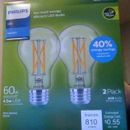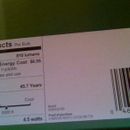“Ultra Efficient” LED Bulbs now available for sale in the US, Europe
Several years ago someone posted an article about the special “Dubai Bulbs” sold by Phillips. These had an efficiency of around 200 watts per lumen, twice the norm for LEDs.
In January of this year someone here told me a similar bulb was for sale in the USA. So I picked up a few on Amazon. They put out 800 lumens, in the standard A19 form factor, using only 4 watts.
Today that model is not available. Apparently Phillips has an exclusive deal with walmart.com. I went to my local Walmart; they weren’t on the shelves. The app said otherwise and let me order online for same day pickup (minimum is 4 to avoid a “shipping” charge). Lo and behold: I was notified an hour later that the bulbs were waiting for me in the same store. I guess they keep them in the back, hidden from the “masses.”
I have attached photos of the front and the rear of the package, for you energy nerds.
They use 0.5 more watts than before but put out 10 more lumens.
Phillips has similar bulbs for sale in Europe at lights.co.uk and I was also able to find decorative ones on Google, in the Netherlands. Can you find them in your country?
GBA Detail Library
A collection of one thousand construction details organized by climate and house part











Replies
I see Walmart has 60 and 100 watt equivalents online but they're described as non-dimmable which makes me not interested. I'd rather use an extra few watts and be able to adjust brightness, but maybe dimmers will become compatible with them over time.
A policy comment:
Who remembers when the federal government mandated the phasing out of incandescent bulbs? Remember the howls of protest?
In retrospect, that policy was an enormous success. It spurred the development of LED lights that are superior to the incandescents they replaced in every regard.
DC,
Agreed.
I agree.
Now all we need is an equivalent improvement in lighting design and lighting fixtures. I struggle with so many interiors that have terrible glare issues. LEDs make it just that much harder because they are such tiny and intense point sources.
LEDs are not superior in terms of CRI/TM30 color rendering, and this is exacerbated by stringent energy efficiency requirements. LEDs naturally generate a single wavelength of light. Obviously you add different colored LEDs to achieve a mix of colors (RGB), but the color accuracy is not very good. To get good warm white lighting, a blue LED is phosphor coated to transform that single wavelength to a mix of longer wavelengths. This phosphor coating has unavoidable losses, and with current technology, the yellower your target output (2700K) the worse those losses are because it is farther from blue.
Of course you can just add more LEDs driven at low power for higher efficiency, but won't anyone think of the manufacturer's profits?
Very informative. Thanks.
How do yellow LEDs with losses compare to other readily available types of bulbs? What kind of inefficiencies are we talking about compared to blue LEDs?
Warm white LED bulbs are roughly 10-15% less efficient than a pure blue LED, but that wouldn't be pleasant. https://www.nature.com/articles/s41438-020-0283-7. The only other common bulbs are CFLs but those are trash for numerous reasons and basically obsolete.
If you're interested in digging deep into a comparison of different LED bulbs on the market check out this video https://www.youtube.com/watch?v=XeR2uPPCA2k. There's a lot of nuance with LEDs if you are interested.
The biggest potential issue I see with these (that I wonder if anyone has actually analyzed -- I might need to buy some to test myself) is flicker. They look like they're the "filament" style with no driver circuitry, just long strings of LEDs directly across the AC line. Helps efficiency a bit by eliminating the conversion losses of LED drive circuitry, but also eliminates any filtering so they've probably got pretty bad 120Hz flicker.
@DCcontrarian: Though I have little nostalgia for incandescent lights, I wish it were easier to find trustworthy, quality LED lights. If anything, as their popularity has increased I feel like quality has gone down. Home Depot store shelves for example are almost entirely their house brand, which seems to be of the tier that lasts substantially less than 15000 hours. Perhaps it's just infant mortality, of a higher percentage than I would want, and the rest will be fine, but they seem to go to "blink on and off mode" in months at times. Amazon likewise is flooded with no-name, dubious quality bulbs. CRI ratings for anything, when present, are always a bit questionable, and hardly anyone goes into more detail beyond "80" or "90+" -- and basically nobody mentions R9 or flicker.
"Filament style" is actually superior because you're separating the heat generated by the light source vs the driver circuitry. Cheap A19 bulbs cram both the LEDs and the driver into the base of the bulb, making for a hotspot of heat. Heat is the #1 killer of LEDs and electronics in general.
Flickering really has nothing to do with whether the LED chips are filaments vs squares. It has everything to do with extra electronic components in the driver to cleanly convert AC to DC power (especially with nasty leading-edge dimming), limit inrush current, and dissipate leftover energy when turned off. You get what you pay for here. This "Philips" ultra-efficient has extra circuitry to do better here: https://www.youtube.com/watch?v=nMc6mjE9Y1s
Huh, thanks for that link, I didn't realize they had hidden driver circuitry of any sort in the base. I've seen cheaper filament style bulbs that had little to no filtering or drive circuitry, thus my negative association with the style. I might need to pick up some of these to try!
The same guy did a teardown of the original "Dubai lamp" here https://www.youtube.com/watch?v=klaJqofCsu4 which has a bit different drive circuitry, also an interesting watch.
If this lamp is the same as the Dubia lamp there is a lot of driver circuit hidden in the screw base.
https://www.youtube.com/watch?v=klaJqofCsu4
At $15 how many hours would one need to operate the lamp to recover its costs with your electric rates?
If it uses half the power then you would need to burn $30 of electricity to get to break even.
1000\8.4 watts = 119 hours per kWh. My cost per kWh is $0.10 $30 / 0.10 = buys 300 kWh x 119 = 35700 hours. 35700/24= 14875 days 14875/365 =over 4 years of continuous operation
Walta